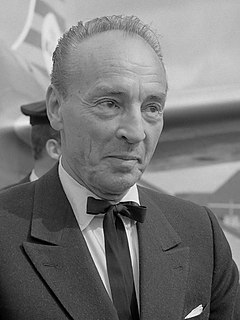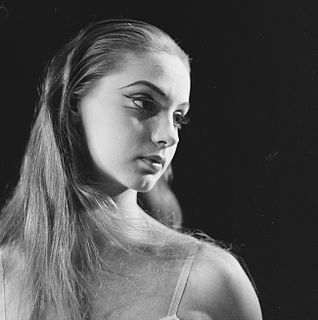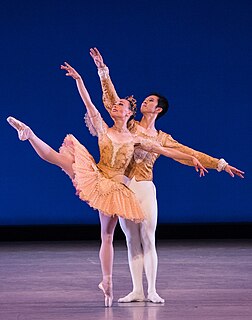Related Research Articles

George Balanchine was an American ballet choreographer who was one of the most influential 20th-century choreographers. Styled as the father of American ballet, he co-founded the New York City Ballet and remained its Artistic Director for more than 35 years. His choreography is characterized by plotless ballets with minimal costume and décor, performed to classical and neoclassical music.

New York City Ballet (NYCB) is a ballet company founded in 1948 by choreographer George Balanchine and Lincoln Kirstein. Balanchine and Jerome Robbins are considered the founding choreographers of the company. Léon Barzin was the company's first music director. City Ballet grew out of earlier troupes: the Producing Company of the School of American Ballet, 1934; the American Ballet, 1935, and Ballet Caravan, 1936, which merged into American Ballet Caravan, 1941; and directly from the Ballet Society, 1946.
Gelsey Kirkland is an American ballerina. She received early ballet training at the School of American Ballet. Kirkland joined the New York City Ballet in 1968 at age 15, at the invitation of George Balanchine. She was promoted to soloist in 1969, and principal in 1972. She went on to create leading roles in many of the great twentieth century ballets by Balanchine, Jerome Robbins, and Antony Tudor, including Balanchine's revival of The Firebird, Robbins' Goldberg Variations, and Tudor's The Leaves are Fading. Balanchine re-choreographed his version of Stravinsky's The Firebird specifically for her. She left the New York City Ballet to join the American Ballet Theatre in 1974 as a principal dancer.

Suzanne Farrell is an American ballerina and the founder of the Suzanne Farrell Ballet at the Kennedy Center in Washington, D.C.

Apollo is a neoclassical ballet in two tableaux composed between 1927 and 1928 by Igor Stravinsky. It was choreographed in 1928 by twenty-four-year-old George Balanchine, with the composer contributing the libretto. The scenery and costumes were designed by André Bauchant, with new costumes by Coco Chanel in 1929. The scenery was executed by Alexander Shervashidze, with costumes under the direction of Mme. A. Youkine. The American patron of the arts Elizabeth Sprague Coolidge had commissioned the ballet in 1927 for a festival of contemporary music to be held the following year at the Library of Congress in Washington, D.C.

Nicholas Magallanes was a principal dancer and charter member of the New York City Ballet. Along with Francisco Moncion, Maria Tallchief, and Tanaquil Le Clercq, Magallanes was among the core group of dancers with which George Balanchine and Lincoln Kirstein formed Ballet Society, the immediate predecessor of the New York City Ballet.

Theme and Variations is a ballet choreographed by George Balanchine to the final movement of Tchaikovsky's Orchestral Suite No. 3. The ballet was made for Ballet Theatre, and premiered on November 26, 1947, at the City Center 55 Street Theater, with the two leads danced by Alicia Alonso and Igor Youskevitch.

Le chant du rossignol is a symphonic poem written by Igor Stravinsky in 1917. The score is adapted from his earlier work, Le rossignol, an opera from 1914. The opera, based on Hans Christian Andersen's 1843 tale "The Nightingale", is set in three acts, told from the point of view of a Chinese fisherman. In the orchestral version, Stravinsky mostly uses music from acts two and three.
Symphony in Three Movements is a neoclassical ballet choreographed by George Balanchine to the music of the same name by Stravinsky. The ballet was made for the New York City Ballet Stravinsky Festival in 1972, a tribute to the composer following his death. The ballet premiered on June 18, 1972, at the New York State Theater.
The Cage is a ballet choreographed by Jerome Robbins to Stravinsky's Concerto in D. The ballet depicts a tribe of female insects that preys on their male counterparts, in which the Novice falls in love with a male intruder, before being overcome by her animal instincts to kill him. The Cage was made for the New York City Ballet, and premiered on June 10, 1951, at the City Center of Music and Drama, with Nora Kaye as the Novice.

Kay Mazzo is an American former ballet dancer and educator. In 1961, she joined Jerome Robbins' company, Ballets USA. The following year, she joined the New York City Ballet, and was promoted to principal dancer in 1969. She created roles for George Balanchine and Robbins, before retiring from performing in 1981. She then joined the permanent faculty of the School of American Ballet in 1983, named co-chairman of faculty in 1997 and chair of faculty in 2018. She stepped down from the position in June 2022, but continues to teach.

Who Cares? is a ballet choreographed by George Balanchine to songs by George Gershwin that were orchestrated by Hershy Kay. The ballet is split in two parts, the first danced by an ensemble, and the second focuses on four principal dancers. Who Cares? premiered on February 5, 1970, at the New York State Theater, danced by the New York City Ballet.
Monumentum pro Gesualdo is a ballet by the New York City Ballet (NYCB) co-founder and balletmaster George Balanchine to music by Igor Stravinsky composed in honor of the 400th birthday of the composer Carlo Gesualdo and consisting of Stravinsky's orchestrations of Gesualdo's madrigals. The premiere took place on Wednesday, November 16, 1960, at City Center of Music and Drama, New York, with scenery and lighting by David Hays and was conducted by Robert Irving. The composer conducted the score's orchestral premiere on Tuesday, September 27, 1960, for the XXIII Venice Music Festival at La Fenice.
Scherzo à la Russe is a ballet choreographed by George Balanchine to Stravinsky's music of the same name. The ballet was created for New York City Ballet's Stravinsky Festival, a tribute to the composer after his death, and premiered on June 21, 1972, at the New York State Theater, with the two lead roles originated by Karin von Aroldingen and Kay Mazzo.
Yvonne Mounsey was a South African-American ballet dancer and teacher. Described as "a dancer of glamour, wit, and striking presence," she spent ten years with the New York City Ballet (1949-1959), where she created important roles in the works of George Balanchine and Jerome Robbins.

Olga Elise Reiman was an American ballet dancer and dance educator. After starting her career working with choreographer Adolph Bolm, she danced at the American Ballet and Ballet Society, both forerunners of the New York City Ballet, and originated roles several roles for choreographer George Balanchine. Reiman taught at Balanchine's School of American Ballet between 1945 to 1953 and from 1964 until her death.
Stravinsky Violin Concerto, originally titled Violin Concerto, is a neoclassical ballet choreographed by George Balanchine to Stravinsky's Violin Concerto. Balanchine had previously choreographed another ballet to the concerto in 1941 for the Original Ballet Russe, titled Balustrade, though it was not revived following a few performances. He then reused the concerto for New York City Ballet's Stravinsky Festival in 1972, a tribute to the composer following his death. The ballet premiered on June 18, 1972, at the New York State Theater.
Stephanie Saland is an American former ballet dancer and teacher. She was spotted by George Balanchine whilst a student at the School of American Ballet, then joined the New York City Ballet in 1972, and was promoted to principal dancer in 1984. She had created roles for both Balanchine and Jerome Robbins, before retiring in 1993. She then started teaching ballet in both the U.S. and internationally.
Duo Concertant is a ballet choreographed by George Balanchine to Stravinsky's score of the same name. The ballet was created for New York City Ballet's Stravinsky Festival, a tribute to the composer a year after his death, and premiered on June 22, 1972, at the New York State Theater, danced by Kay Mazzo and Peter Martins.
References
- 1 2 3 Commire, Anne; Klezmer, Deborah, eds. (2006). "Flagg, Elise (1951–)". Dictionary of Women Worldwide: 25,000 Women Through the Ages.
- ↑ Neale, Wendy (1982). Ballet Life Behind the Scenes: From Classes, Rehearsals, and Performances to the Company and Home Lives of the Dancers. Crown. pp. 52–3.
- ↑ Goldner, Nancy (1974). The Stravinsky Festival of the New York City Ballet. Eakins Press. p. 129. ISBN 9780871300379.
- ↑ Reynolds, Nancy (1977). Repertory in Review: 40 Years of the New York City Ballet. Dial Press. p. 299. ISBN 9780803773684.
- ↑ Addy, Jason (October 8, 2020). "New Geneva Studio Offers Safe Space For Dancers Amid Pandemic". Patch . Retrieved September 7, 2022.